Intentional fouling in the NBA Playoffs
Clank… Clank… The sound of the basketball bouncing off the rim during free throws has been quite common so far this 2015 NBA playoffs. More and more teams have turned to intentionally fouling poor free throw shooters as a defensive game plan. The idea is to repeatedly foul a player who shoots near or worse than 50 percent to slow down their offense and reduce the amount of points scored by the opposing team. However, this type of play extends the length of the game and is boring for spectators.
“From a pure entertainment purpose, it just completely slows down the game,” Ronak Baldua (11) said. “One of the main reasons people watch basketball is for the fast pace that the game is played at, and when you have a guy taking 34 free throws in a half, it’s slowing it down and taking away from the entertainment value.”
Fans and even other players have expressed their hate towards the strategy by booing whenever a team resorts to “hacking” a player. In addition, some have petitioned for an NBA rule change, possibly banning intentional fouls.
Despite the criticism, when there are players like Deandre Jordan and Dwight Howard shooting 42.4 percent and 41.2 percent from the free throw line in the playoffs, fouling them would seem viable and effective. The strategy has displayed mixed results. In the first round series between the Houston Rockets and the Dallas Mavericks, the only game Dallas won (game four) was also the game where Howard shot 13 free throws, the most he attempted during the series.

Deandre Jordan bends his knees and prepares to shoot a free throw. He has shot 41.7 percent since entering the league in 2008.
Though hacking was successful that particular instance, it has backfired more often than not. In game two between the Los Angeles Clippers and the Rockets, Howard was fouled repeatedly and ended the game shooting 8-21 from the free throw line. Despite the poor shooting, the Rockets still won the game. Similarly, when Jordan was deliberately fouled by the Rockets, he shot an all-time playoff high of 34 free throws. He made only 14, but the Clippers still won by 33 points.
NBA commissioner Adam Silver told ESPN that the association is going to have multiple meetings discussing the topic.
“We have another general managers meeting coming up in May, we have a competition committee meeting in June, and I’m sure it’s going to be a hot topic of discussion,” he told ESPN. “Then, we have an owners meeting in July, so I think at all three of those meetings we’re going to be having full-throated conversations about what the right rules should be going forward.”
As the playoffs continue, it will be interesting to see if teams continue to abuse the strategy, and whether or not they will be successful. A potential solution to this growing problem is quite simple: just make the free throws. They are a fundamental part of the game, and professional basketball players should be expected to make them consistently.
Neil Bai (12) is the senior copy editor for Harker Aquila and is tasked with copy editing and approving all articles before they are published. Neil’s...


















![“[Building nerf blasters] became this outlet of creativity for me that hasn't been matched by anything else. The process [of] making a build complete to your desire is such a painstakingly difficult process, but I've had to learn from [the skills needed from] soldering to proper painting. There's so many different options for everything, if you think about it, it exists. The best part is [that] if it doesn't exist, you can build it yourself," Ishaan Parate said.](https://harkeraquila.com/wp-content/uploads/2022/08/DSC_8149-900x604.jpg)




![“When I came into high school, I was ready to be a follower. But DECA was a game changer for me. It helped me overcome my fear of public speaking, and it's played such a major role in who I've become today. To be able to successfully lead a chapter of 150 students, an officer team and be one of the upperclassmen I once really admired is something I'm [really] proud of,” Anvitha Tummala ('21) said.](https://harkeraquila.com/wp-content/uploads/2021/07/Screen-Shot-2021-07-25-at-9.50.05-AM-900x594.png)







![“I think getting up in the morning and having a sense of purpose [is exciting]. I think without a certain amount of drive, life is kind of obsolete and mundane, and I think having that every single day is what makes each day unique and kind of makes life exciting,” Neymika Jain (12) said.](https://harkeraquila.com/wp-content/uploads/2017/06/Screen-Shot-2017-06-03-at-4.54.16-PM.png)








![“My slogan is ‘slow feet, don’t eat, and I’m hungry.’ You need to run fast to get where you are–you aren't going to get those championships if you aren't fast,” Angel Cervantes (12) said. “I want to do well in school on my tests and in track and win championships for my team. I live by that, [and] I can do that anywhere: in the classroom or on the field.”](https://harkeraquila.com/wp-content/uploads/2018/06/DSC5146-900x601.jpg)
![“[Volleyball has] taught me how to fall correctly, and another thing it taught is that you don’t have to be the best at something to be good at it. If you just hit the ball in a smart way, then it still scores points and you’re good at it. You could be a background player and still make a much bigger impact on the team than you would think,” Anya Gert (’20) said.](https://harkeraquila.com/wp-content/uploads/2020/06/AnnaGert_JinTuan_HoHPhotoEdited-600x900.jpeg)

![“I'm not nearly there yet, but [my confidence has] definitely been getting better since I was pretty shy and timid coming into Harker my freshman year. I know that there's a lot of people that are really confident in what they do, and I really admire them. Everyone's so driven and that has really pushed me to kind of try to find my own place in high school and be more confident,” Alyssa Huang (’20) said.](https://harkeraquila.com/wp-content/uploads/2020/06/AlyssaHuang_EmilyChen_HoHPhoto-900x749.jpeg)



